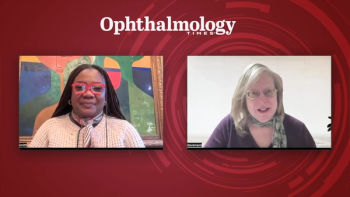
An eye on how patients perceive their retinal diseases
Key Takeaways
- Patients with neovascular AMD and DME experience significant treatment burdens, including logistical, emotional, and financial challenges, impacting their quality of life.
- A disconnect exists between patient and clinician perceptions, with physicians underestimating the impact of treatment on patients' lives and overestimating their acceptance of injections.
A recent study identified a large disconnect between patients with neovascular
“From the patient perspective, the burden of anti-vascular endothelial growth factor treatment extends beyond the clinical setting,” the investigators stated.
These “logistical challenges” to the regular visits include barriers to transportation, absenteeism from work, the need for a caregiver,2-4 side effects in about 50% of patients from the injections that require time off from daily activities and work to recover,2 and significant fear and anxiety related to the injection procedure3. Additional emotional and psychological factors include fear of vision loss, depression, and anxiety about long-term disease management.3,4
In some cases, patients may need psychotherapy, support groups, and services for those with low vision5,6 and experience a financial strain associated with the direct and indirect costs of their care.3
Patients also reported dissatisfaction with the injection frequency and the cumulative toll of ongoing treatment of AMD and DME.7 “These factors, combined with the physical discomfort and anxiety around the injection procedure itself, contribute to a multidimensional disease burden,”² the authors said.
On the flip side, physicians can underestimate the effects of these conditions on patient quality of life,8,9 barriers that can result in nonadherence and undertreatment, contributing to suboptimal patient outcomes that are observed in real-world studies compared with the (VEGF) clinical trials.3,10,11
Robinson and colleagues undertook this survey study to determine how patients with neovascular AMD or DME perceive their disease and its treatment and assess the degree of alignment between patient and clinician perceptions.
To that end, they developed three surveys: one tailored for patients with DME, one for patients with neovascular AMD, and one for clinicians who injected anti-VEGF agents to capture their data.
The surveys were completed by 101 patients, 50 with AMD and 51 with neovascular AMD in June 2024, and 100 ophthalmologists who treat these conditions.
What were the survey results of the AMD and DME patients?
The investigators reported the following key points:
- 66% and 86% of patients with DME and neovascular AMD, respectively, reported receiving intravitreal injections at least once every 8 weeks.
- 82% required a caregiver and/or public transportation to get to their appointments.
- Vision loss over time and blurred or double vision were the most significant symptoms for patients with DME, and for those with neovascular AMD, poor night vision, seeing in low-light conditions, and blurred vision.
- Dissatisfaction levels with education and counseling about their disease were higher for those with neovascular AMD, 31%, compared with DME (11%), which reached significance P< 0.01).
- Ophthalmologists overestimated the extent to which patients perceived that injections were necessary and that patients experienced insurance barriers to receiving treatment (P < 0.01 for both comparisons).
- They also overestimated the extent to which patients became less nervous with subsequent injections after the first injection and underestimated their difficulty of getting to appointments (P < 0.01 for both comparisons).
Robinson and colleagues concluded, “The findings of this survey study call attention to key barriers to effective treatment for patients and critical areas where patient and clinician perceptions of disease and treatment burdens are misaligned. Overall, these results underscore the large burden that patients face in undergoing treatment for neovascular AMD and DME. In the future, therapy that provides greater durability, fewer injections, and fewer clinic visits can help reduce the burden for patients, improve adherence, and facilitate better overall patient outcomes. Furthermore, optimal treatment will require greater understanding and communication between patients and clinicians.”
References
Robinson K, Cooper SJ, Persaud S, Frederick JL, Singh RP. Discordance among patients and ophthalmologists regarding the burden of intravitreal injections.Clin Ophthalmol. 2025;19:2637-2645.
https://doi.org/10.2147/OPTH.S532179 Holekamp N, Gentile B, Giocanti-Aurégan A, et al. Patient experience survey of anti-vascular endothelial growth factor treatment for neovascular age-related macular degeneration and diabetic macular edema.Ophthalmic Res. 2024;67:311–321. doi:10.1159/000538975
Müller S, Junker S, Wilke T, et al. Questionnaire for the assessment of adherence barriers of intravitreal therapy: the ABQ-IVT.Int J Retina Vitreous. 2021;7:43. doi:10.1186/s40942-021-00311-x
Reitan G, Haugen IBK, Andersen K, Bragadottir R, Bindesbøll C. Through the eyes of patients: understanding treatment burden of intravitreal anti-VEGF injections for nAMD patients in Norway.Clin Ophthalmol. 2023;17:1465–1474. doi:10.2147/opth.S409103
Jamous KF, Jalbert I, Kalloniatis M, Boon MY. Australian optometric and ophthalmologic referral pathways for people with age-related macular degeneration, diabetic retinopathy and glaucoma.Clin Exp Optom. 2014;97:248–255. doi:10.1111/cxo.12119
Mitchell P, Liew G, Gopinath B, Wong TY. Age-related macular degeneration.Lancet. 2018;392(10153):1147–1159. doi:10.1016/s0140-6736(18)31550-2
McClard CK, Wang R, Windham V, et al. Questionnaire to assess life impact of treatment by intravitreal injections (QUALITII): development of a patient-reported measure to assess treatment burden of repeat intravitreal injections.BMJ Open Ophthalmol. 2021;6:e000669. doi:10.1136/bmjophth-2020-000669
Stein JD, Brown MM, Brown GC, Hollands H, Sharma S. Quality of life with macular degeneration: perceptions of patients, clinicians, and community members.Br J Ophthalmol. 2003;87:8–12. doi:10.1136/bjo.87.1.8
Robinson K, Cooper S, Persaud S, Singh R.Identifyingdiscordance among patients and clinicians regarding the burden of intravitreal injections. Presented at: Retina World Congress 2025; Fort Lauderdale, FL. 2025.
Polat O, İnan S, Özcan S, et al. Factors affecting compliance to intravitreal anti-vascular endothelial growth factor therapy in patients with age-related macular degeneration.Turk J Ophthalmol. 2017;47:205–210. doi:10.4274/tjo.28003
Kuo BL, Tabano D, Garmo V, et al. Long-term treatment patterns for diabetic macular edema: up to 6-year follow-up in the IRIS Registry.Ophthalmol Retina. 2024;8:1074–1082. doi:10.1016/j.oret.2024.05.017
Newsletter
Don’t miss out—get Ophthalmology Times updates on the latest clinical advancements and expert interviews, straight to your inbox.













































